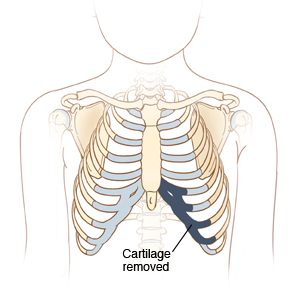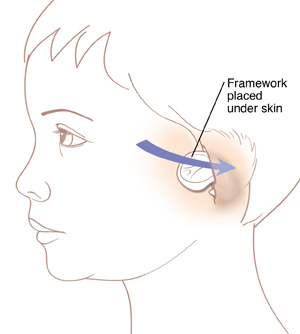Auricular Reconstruction of a Child’s Ear: Phase 1
Your child’s outer ear (auricle) is missing or not developed. This condition is called microtia. Surgery can be done to build your child an outer ear. It may be done over several phases. The exact details of each surgery and the number of surgeries needed depend on the surgeon. It also depends on the structures present in your child’s ear.
In general, phase 1 involves taking strong and flexible tissue (cartilage) from your child’s ribs. This is used to make a framework for the outer ear. Auricular reconstruction is the most common surgery used to fix a missing or underdeveloped ear. Two other options are also available. One uses an artificial mesh in place of cartilage to make the new ear. The other uses a prosthetic artificial ear.
Having no treatment is also an option. Often, microtia happens with varying degrees of hearing loss. Your child's hearing loss may be fixed at a later time through different treatments.


A multistep process
Auricular reconstruction is done during 3 or more surgeries. Phase 1 may be done when a child is around 6 to 10 years old. This is the age that your child can safely give enough cartilage to build the new outer ear. And this is also the age that your child’s normal ear reaches adult size. So the new ear can be made to match it. After this procedure, another 2 to 3 procedures are needed to make the ear for your child. These surgeries are done about 3 to 6 months apart. This gives the skin time to heal. More surgery may be needed as your child ages. Your surgeon can tell you more.
Preparing for phase 1 surgery
In an age-appropriate manner, explain the surgery to your child. Prepare your child for the surgery as you have been told. Tell your healthcare provider about all medicines your child takes. This includes over-the-counter medicines. It also includes herbs and other supplements. Your child may need to stop taking some or all of them before surgery. Also, follow any instructions you’re given for preventing your child from eating or drinking before surgery.
The day of surgery
The phase 1 procedure lasts about 3 to 6 hours. Your child may need to stay in the hospital for 2 or more days afterward. Before surgery starts:
-
To keep your child from feeling pain during the procedure, they are given general anesthesia. This medicine puts your child in a state like deep sleep through the procedure.
-
When your child is asleep, an IV (intravenous) line is put into a vein in your child’s arm or hand. This line gives fluids and medicines. A tube is then passed through your child’s mouth into the windpipe (trachea) to help with breathing during surgery. Special equipment watches your child’s heart rate, blood pressure, and oxygen levels.
During the surgery
-
An outline is made of your child’s normal ear, if one is there. The surgeon then traces this outline onto the child’s skin where the new ear will be made. This helps to make sure the new ear is the correct size and position and is aligned with the other ear.
-
Cartilage is taken from the ribs. To do this, an incision is made on the belly near the bottom of the ribs. The surgeon takes out cartilage from the end of the ribs using special tools. The incision is closed with stitches.
-
A cartilage framework for the new ear is made. The cartilage taken from the ribs is cleaned. It is then carved into a framework for the new ear. The surgeon does this using the template made earlier from the child’s normal ear.
-
The framework is placed on the side of the head. The surgeon makes incisions in the place where the ear will be made. They follow the outlines drawn from the child's normal ear. Any cartilage from the malformed ear is taken out. A skin pocket is made. If needed, the skin is stretched using a special tool. The cartilage framework is put into the skin pocket. Incisions are then stitched closed.
-
Extra cartilage is saved for future surgery phases. Any leftover cartilage is put underneath the skin on your child’s chest. When the surgeon needs this cartilage, they make a small incision in the skin to collect it. Putting it under the skin keeps the cartilage healthy. The surgeon has cartilage to complete the ear without having to harvest it from the ribs each time. This helps limit the amount of pain your child will have.
-
One or more tubes (drains) may be placed into the surgery areas. This drains fluid that builds up after surgery as the area starts to heal.
Recovering in the hospital
When the surgery is done, your child will be taken to a room to wake up from the anesthesia. You may be able to see your child at this time. Your child will be watched as they rest. Pain medicine can be given if needed. It may be given through the IV or through a catheter that was placed in the chest. When ready, you and your child may be taken to a hospital room to stay for 1 or more nights. You will be told when you can take your child home.
Recovering at home
Once home, follow any instructions you are given for caring for your child. During your child’s recovery:
-
Give prescribed medicines as told. Even if your child doesn’t complain of pain, give the medicine on time. Don't wait for the pain to get bad. This makes the pain harder to control.
-
Do your best to prevent your child from touching the ear. Don’t let siblings or other children touch your child’s ear or play roughly around your child as they heal.
-
If your child is sent home with a tube (drain) in a wound, follow your healthcare provider’s instructions for how to care for it.
When to call the healthcare provider
Be sure you have a contact number for your child’s surgeon/healthcare provider. After you get home, call if your child has any of the following:
-
Fever of 100.4° F ( 38° C) or higher, or as directed by your surgeon
-
Bleeding or a large amount of drainage from an incision
-
Symptoms of infection at an incision site, such as increased redness or swelling, warmth, worsening pain, or foul-smelling drainage
-
Any injury to the ear
Follow-up
Take your child to scheduled follow-up visits. If appropriate for your child's age, encourage them to write down questions or concerns about the procedure. Make time during the visit to talk about your child's questions or concerns. During these visits, the surgeon will check on your child and make sure the ear is healing correctly. You can also talk about and schedule any more surgeries needed to construct the ear.
Risks and possible complications
All procedures have risks. The risks of this procedure include:
-
Bleeding
-
Infection
-
Risks of anesthesia. You will talk about these with the anesthesiologist.
-
Not liking how the ear looks after surgery
-
Cartilage wearing through the skin (extrusion)
-
Injury to the chest wall or lungs during cartilage harvest